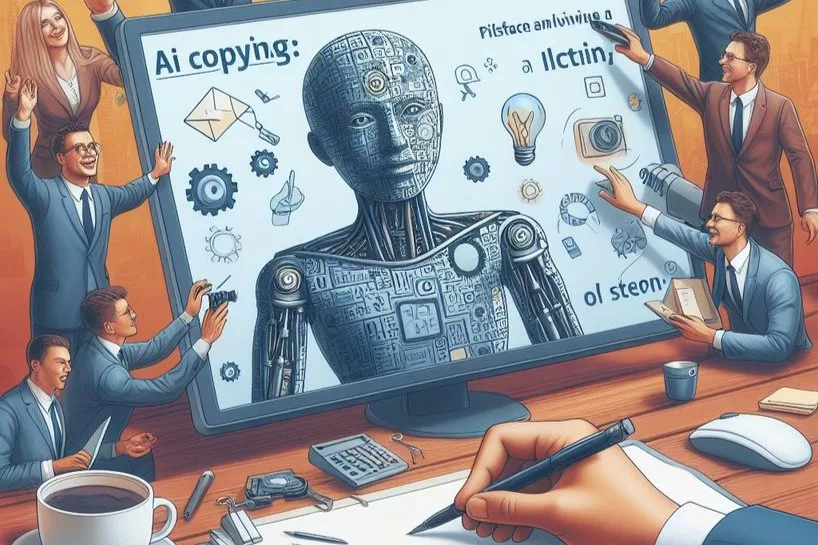What are the top 5 digital marketing trends in 2024? Imagine you are a marketer in 2024. You wake up in the morning and check your smartphone. You see a notification from your AI assistant, telling you that your latest campaign has achieved a 15% increase in conversions, thanks to the personalized and immersive experiences you created for your target audience. You smile and get ready for the day, knowing that you are ahead of the curve in the ever-changing world of digital marketing.
Sounds too good to be true? Well, it might not be as far-fetched as you think. Digital marketing is constantly evolving, and the trends that will shape the industry in 2024 are already emerging.
In this blog post, I will explore the top five digital marketing trends for 2024, and how you can leverage them to grow your business and connect with your customers.
1. The Rise of AI and Machine Learning
Artificial intelligence (AI) and machine learning (ML) are not new concepts, but they are becoming more powerful and accessible than ever before. According to a survey by HubSpot, 63% of marketers plan to increase their AI and ML budgets in 2024.
AI and ML can help marketers automate tasks, optimize campaigns, generate insights, and create personalized and relevant content for their audiences. For example, AI and ML can help you:
- Analyze customer behavior and preferences, and segment them into different personas and journeys.
- Create dynamic and responsive websites and landing pages that adapt to the user’s context and intent.
- Generate engaging and creative headlines, captions, slogans, and copy for your ads, social media posts, and blogs.
- Optimize your bidding and targeting strategies for your paid media campaigns, and measure your return on ad spend (ROAS).
- Test and improve your conversion rate optimization (CRO) strategies, and identify the best performing elements of your web pages and emails.
AI and ML are not only tools for marketers, but also for customers. More and more consumers are using voice assistants, chatbots, and smart devices to search for information, make purchases, and interact with brands. According to Statista, the global voice and speech recognition market is expected to reach $26.8 billion by 2024.
To stay relevant and competitive, marketers need to optimize their content and campaigns for these new channels and platforms, and provide seamless and conversational experiences for their customers.
2. Voice Search Optimization
Voice search is not a new trend, but it is becoming more popular and prevalent, especially among younger generations. That’s why you need to pay attention to this.
According to FinancesOnline, 55% of teens and 41% of adults use voice search daily. Voice search is convenient, fast, and hands-free, and it can provide more accurate and relevant results than text-based search.
Voice search is also changing the way people search for information, as they tend to use more natural and conversational language, and ask longer and more specific questions.
To optimize your content and campaigns for voice search, you need to:
- Use long-tail keywords and phrases that match the user’s intent and query.
- Provide clear and concise answers to common questions that your audience might ask.
- Use schema markup and structured data to help search engines understand and index your content.
- Optimize your website speed and mobile-friendliness, as most voice searches are done on mobile devices.
- Claim and update your Google My Business listing, as voice searches often have local intent.
Voice search optimization can help you improve your organic rankings, increase your traffic, and enhance your brand awareness and authority. To learn more about search engine optimization, read this comprehensive SEO guide.
3. The Emergence of the Metaverse
The metaverse is a term that describes a virtual and immersive environment where people can interact with each other and with digital content, using devices such as virtual reality (VR) headsets, augmented reality (AR) glasses, and smartphones.
The metaverse is not a single platform or application, but a network of interconnected and interoperable virtual worlds, where users can create, explore, socialize, and consume. According to Venture Harbour, the global VR and AR market is expected to grow from $27 billion in 2020 to $209 billion in 2024.
The metaverse offers a huge opportunity for marketers to create innovative and engaging experiences for their customers, and to reach new and untapped audiences. For example, marketers can:
- Create branded virtual worlds and spaces, where customers can interact with the brand’s products, services, and values.
- Sponsor and host virtual events, such as concerts, conferences, and exhibitions, where customers can participate and network with other attendees.
- Collaborate and partner with influencers and creators, who can promote the brand’s products and services to their followers and fans in the metaverse.
- Design and sell digital goods and assets, such as avatars, skins, clothing, and accessories, that customers can use and display in the metaverse.
The metaverse is not a futuristic concept, but a reality that is already happening. Marketers need to embrace and experiment with this new medium, and to understand the needs and expectations of the metaverse users.
4. Social Commerce and In-Feed Shopping
Social media is not only a platform for sharing and consuming content, but also for discovering and buying products and services.
According to HubSpot, 87% of e-commerce shoppers believe that social media helps them make a shopping decision. Social commerce is the process of selling products and services directly on social media platforms, without redirecting the customers to a separate website or app. Social commerce can help marketers increase their sales, conversions, and customer loyalty, by providing a convenient and seamless shopping experience for their customers.
Some of the features and tools that enable social commerce are:
- Shoppable posts and stories, where customers can view and purchase products within the social media app, such as Instagram Shopping and Facebook Shops.
- Buy buttons and checkout options, where customers can complete their transactions without leaving the social media app, such as Pinterest Buyable Pins and Twitter Buy Now.
- Live shopping and video commerce, where customers can watch live or recorded videos of products and services, and buy them in real time, such as Instagram Live Shopping and TikTok Shop Live.
- Social media marketplaces, where customers can browse and buy products from different sellers and brands, such as Facebook Marketplace and Instagram Explore.
Social commerce is not only beneficial for marketers, but also for customers, as it can provide them with more personalized and relevant product recommendations, reviews, and feedback, as well as social proof and trust from their peers and influencers.
5. Personalization and Customer Experience
Personalization and customer experience are not new trends, but they are becoming more important and essential for digital marketing success.
According to HubSpot, 90% of consumers find personalization appealing, and 80% of consumers are more likely to do business with a company that offers personalized experiences. Personalization and customer experience can help marketers increase their customer satisfaction, retention, and loyalty, as well as their revenue and profitability.
To provide personalized and customer-centric experiences, marketers need to:
- Collect and analyze customer data, such as demographics, behavior, preferences, and feedback, and use it to create customer segments and personas.
- Use AI and ML to deliver dynamic and adaptive content and offers, based on the customer’s context, intent, and stage in the buyer’s journey.
- Use omnichannel marketing to create consistent and seamless interactions with customers across different channels and touchpoints, such as email, web, social media, and mobile.
- Use customer feedback and satisfaction surveys to measure and improve the customer experience, and to identify and resolve any pain points or issues.
Personalization and customer experience are not only about delivering the right message to the right person at the right time, but also about creating meaningful and memorable relationships with customers, and exceeding their expectations and needs.
Conclusion: Remember to monitor the actual digital marketing trends in 2024
These are the top five digital marketing trends for 2024 that we believe will have a significant impact on the industry and the customers. By adopting and implementing these trends, you can stay ahead of the curve and gain a competitive edge in the market. However, these trends are not the only ones that you should pay attention to, as digital marketing is constantly evolving and changing. You should always keep an eye on the latest developments and innovations, and be ready to adapt and experiment with new strategies and tactics.
I hope you enjoyed this blog post and found it useful and informative. If you have any questions or comments, please feel free to share them below. We would love to hear from you and learn from your insights and experiences. Thank you for reading and happy marketing!







